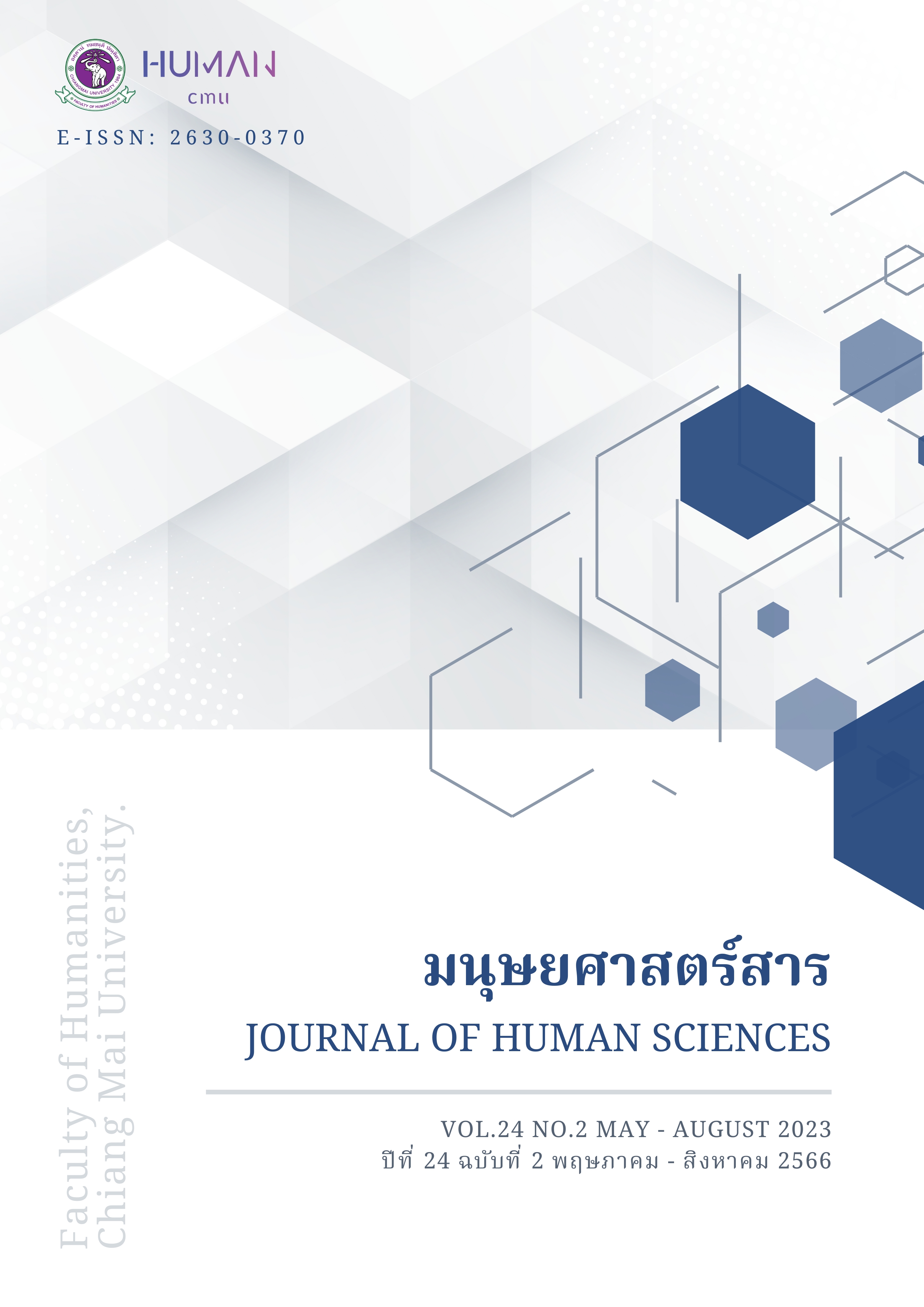ภาษาโน้มน้าวใจในปริจเฉทโฆษณาสินค้าเครื่องดื่มเพื่อสุขภาพ และผลิตภัณฑ์อาหารเสริมเพื่อสุขภาพสำหรับผู้ใหญ่ในเว็บไซต์ RS Mall: การศึกษาตามแนวทางปริจเฉทวิเคราะห์
Main Article Content
บทคัดย่อ
ปัจจุบันโฆษณาสินค้าเครื่องดื่มเพื่อสุขภาพและผลิตภัณฑ์อาหารเสริมเพื่อสุขภาพสำหรับผู้ใหญ่มีแนวโน้มมากขึ้น บทความวิจัยนี้มีวัตถุประสงค์เพื่อศึกษาองค์ประกอบของปริจเฉทโฆษณาสินค้าเครื่องดื่มเพื่อสุขภาพและผลิตภัณฑ์อาหารเสริมเพื่อสุขภาพสำหรับผู้ใหญ่และกลวิธีทางภาษาที่ใช้โน้มน้าวใจในปริจเฉทโฆษณาดังกล่าว โดยเก็บรวบรวมข้อมูลจากเว็บไซต์ RS Mall ในช่วงไตรมาสแรก คือตั้งแต่เดือนมกราคม-มีนาคม 2566 ผลการวิจัยพบว่าชื่อของสินค้า สิทธิพิเศษและสมนาคุณ ระดับความนิยม ราคาของสินค้า ข้อมูลสินค้า ส่วนประกอบหรือสารสกัดสำคัญ และมาตรฐานการรับรอง เป็นองค์ประกอบสำคัญของปริจเฉทโฆษณาสินค้าเครื่องดื่มเพื่อสุขภาพและผลิตภัณฑ์อาหารเสริมเพื่อสุขภาพสำหรับผู้ใหญ่ที่ส่งผลต่อการโน้มน้าวใจผู้บริโภคกลุ่มเป้าหมาย ทั้งนี้ ผู้ผลิตโฆษณาจะใช้ภาษาเป็นเครื่องมือสำคัญในการโน้มน้าวใจ โดยกลวิธีทางภาษาที่ใช้โน้มน้าวใจที่พบในงานวิจัยนี้ ได้แก่ การเลือกใช้ศัพท์ การกล่าวอ้าง การใช้มูลบท และการใช้วัจนกรรมกลุ่มผูกมัด เพื่อทำให้ผู้บริโภคกลุ่มเป้าหมายเห็นความสำคัญและความจำเป็นของการบริโภคสินค้าเครื่องดื่มเพื่อสุขภาพและผลิตภัณฑ์อาหารเสริมเพื่อสุขภาพ อีกทั้งยังสร้างความน่าเชื่อถือและความเชื่อมั่นต่อสินค้าจนนำไปสู่การกระตุ้นให้เกิดพฤติกรรมการบริโภคเพื่อสุขภาพ
Article Details

อนุญาตภายใต้เงื่อนไข Creative Commons Attribution-NonCommercial-NoDerivatives 4.0 International License.
เอกสารอ้างอิง
กรพัฒน์ โรจน์ธนานันต์ และคณะ. (2565). องค์ประกอบและกลวิธีทางภาษาที่ใช้โน้มน้าวใจในโฆษณาภายนอกรถ โดยสารประจำทางขสมก.และรถร่วมบริการขสมก. วารสารศรีนครินทรวิโรฒวิจัยและพัฒนา (สาขา มนุษยศาสตร์และสังคมศาสตร์), 14(27), 1-13. https://ejournals.swu.ac.th/index.php/swurd/ article/view/14482/11795
กรมอนามัย. (2566). ศูนย์ข้อมูลสุขภาพ: ข้อมูลพื้นฐานของวัยทำงาน ปีงบประมาณ 2566. ฐานข้อมูลกลาง. https://dohdatacenter.anamai.moph.go.th/cognoslogon/index.php?r=groupdata/index&group =1&id=3
กฤติน ขันละ. (2565). ปริจเฉทวิเคราะห์ในโฆษณาออนไลน์ผลิตภัณฑ์เสริมอาหารเพื่อสุขภาพสำหรับผู้หญิง. [วิทยานิพนธ์ปริญญามหาบัณฑิตไม่ได้ตีพิมพ์]. มหาวิทยาลัยขอนแก่น.
นพวัฒน์ สุวรรณช่าง. (2553). การใช้ภาษาโน้มน้าวใจในบทโฆษณาในนิตยสารสุขภาพ. [วิทยานิพนธ์ปริญญา มหาบัณฑิต, จุฬาลงกรณ์มหาวิทยาลัย]. CUIR. http://cuir.car.chula.ac.th/handle/123456789/20694
ปัทมา เหมือนสมัย. (2563). การศึกษาปริจเฉทโฆษณาประกันสุขภาพในสื่อออนไลน์. วารสารภาษาและ วรรณคดีไทย, 37(1), 31-72. https://so04.tci-thaijo.org/index.php/THlanglit/article/view/244062
พรรณธร ครุธเนตร และ ปัณณรัช ชูเชิด. (2563). การใช้ภาษาโน้มน้าวใจในโฆษณาบ้านบนเฟซบุ๊กของบริษัท อสังหาริมทรัพย์. วารสารวจนะ, 8(2), 25-43. http://rs.mfu.ac.th/ojs/index.php/vacana/ article/ view/294
วิริยวิศศ์ มงคลยศ. (2560). กลวิธีการนำเสนอและการใช้ภาษาของโฆษณาเครื่องดื่มเพื่อสุขภาพประเภท ฟังก์ชันนัลดริงก์ในสื่อเฟชบุ๊ก. [วิทยานิพนธ์ปริญญามหาบัณฑิต, มหาวิทยาลัยบูรพา]. Burapha University Library. https://webopac.lib.buu.ac.th/Catalog/BibItem.aspx?BibID=b00246966
วิรัช วงศ์ภินันท์วัฒนา และ ธนพล เอกพจน์. (2564). กลวิธีทางภาษาในการโฆษณาอาหารเสริมสร้างกล้ามเนื้อ สำหรับผู้ชาย. วารสารวิชาการมนุษยศาสตร์และสังคมศาสตร์ มหาวิทยาลัยบูรพา, 29(3), 104-128. https://ojs.lib.buu.ac.th/index.php/huso2/article/view/7749
สุรเกียรติ อาชานานุภาพ. (2559). อยากสุขภาพดี ต้องมี 3 อ.: สำหรับวัยทำงาน. โครงการจัดการความรู้สุขภาพ ผ่านสื่อและเทคโนโลยีออนไลน์ มูลนิธิหมอชาวบ้าน สนับสนุนโดยสำนักกองทุนสนับสนุนการสร้างเสริม สุขภาพ (สสส.).
Borchers, T. A. (2005). Persuasion in the media age. McGraw-Hill.
Brown, G., & Yule, G. (1983). Discourse analysis. Cambridge University Press.
Cook, G. (1992). Discourse. Oxford University Press.
Cook, G. (2001). The discourse of advertising. (2nd ed.). Routledge.
Goddard, A. & Carey, N. (2017). Discourse: The basics. Routledge.
Harris, Z. (1951). Methods in structural linguistics. University of Chicago Press.
Janoschka, A. (2004). Web advertising: New forms of communication on the internet. John Benjamins Publishing.
Jefkins, F. (1995). Advertising. (5th ed.). Made Simple.
Larson, C. U. (2001). Persuasion: Reception and responsibility. Wadsworth/Thomson Learning.
Lerlertyuttitham, P. (2015). Advertising language and persuasion. MANUSYA: Journal of Humanities, 21(Special Issue), 50-59.
Levinson, S. (1983). Pragmatics. Cambridge University Press.
Machin, D., & Mayr, A. (2012). How to do critical discourse analysis: A multimodal introduction. SAGE.
O’Keefe, D. J. (2002). Persuasion: Theory and research. Sage Publications.
Perloff, R. M. (2017). The dynamics of persuasion: Communication and attitude in the twenty- first century. (6th ed.). Routledge.
Rogers, W. (2007). Persuasion: Messages, receivers and contexts. Rowman & Littlefield Publishers.
Romanik, A. (2014). Manipulation in Russian advertising of nutriments and dietary supplements. Studia Linguistica Universitatis lagellonicae Cracoviensis, 131(3), 269-278.
Romanova. D. I., & Smirnova, I. (2019). Persuasive technique in advertising. Training, Language and Culture, 3(2), 55-70.
RS GROUP. (2022). Annual report 2022. https://ir.rs.co.th/th/downloads/yearly-reports
RS GROUP. (2023). Press release. https://ir.rs.co.th/th/updates/press-releases
RS Mall. (2021). About RS Mall. https://www.rsmall.com/page/about-us
Schiffrin, D. (2006). Discourse. In R. Fasold, & J. Connor-Linton (Eds.) An introduction to language and linguistics (pp. 169-203). Cambridge University Press.
Schooness, A., Young, T & Volmink, J. (2013). The advertising of nutritional supplements in South African women’s magazines: A decriptive survey. South African Journal of Clinical Nutrition, 26(2): 12-18.
Searle, J. R. (1976). The classification of Illocutionary acts, Language in Society, 5, 1-24.
Simons, H. W. (2011). Persuasion in society. Sage Publications.
Simon, S. & Dejica-Cartis, D. (2015). Speech acts in written advertisements: Identification, classification and analysis. Procedia-Social and Behavioral Sciences, 192, 234-239.
Stubbs, M. (1983). Discourse analysis: The sociolinguistic analysis of natural language. University of Chicago Press.
Van Dijk, T. A. (2008). Discourse and power. Palgrave Macmillan.
Williamson, J. (2002). Decoding advertisements: Ideology and meaning in advertising. Marion Boyars.


